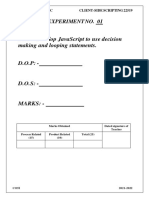Python Micro-Project AH
Uploaded by
darandalem505Python Micro-Project AH
Uploaded by
darandalem5052023-24 QR code Generator using Python
INDEX
Sr.No. Title Page No.
1) Introduction 5
2) Literature Survey 6
3) Requirements 7
4) Application 9
5) Advantages / Disadvantages 11
6) Software / Hardware Requirements 12
7) Coding 13
8) Output / Screenshots 14
9) Conclusion 15
10) Reference 16
Ashok Institute of Engineering & Technology Polytechnic, Ashok Nagar .
2023-24 QR code Generator using Python
Chapter 1
INTRODUCTION
A QR (Quick Response) code is a two-dimensional barcode that can store various
types of data, such as text, URLs, contact information, and more. It's widely used
for quick and easy sharing of information in various applications, including
marketing, authentication, inventory management, and mobile payments.
Python provides libraries like qrcode and PIL (Python Imaging Library) that
allow developers to generate QR codes programmatically. Below is a brief
introduction to creating a QR code generator using Python:
1. Installing Required Libraries: Before creating a QR code generator,
you need to install the necessary libraries.
Ashok Institute of Engineering & Technology Polytechnic, Ashok Nagar .
2023-24 QR code Generator using Python
Chapter 2
LITERATURE SURVEY
As of my last update in January 2022, there are several Python libraries available
for generating QR codes. Here's a literature survey covering some of the popular
ones:
1. qrcode: This is a simple and popular Python library for generating QR
codes. It allows you to create QR codes with various configurations such
as error correction level, box size, and border size. The library is actively
maintained and has good community support.
2. Pillow (Python Imaging Library - PIL): While not specifically
designed for QR code generation, Pillow is a powerful library for image
manipulation in Python. It can be used in conjunction with other libraries
like qrcode to generate QR codes and further customize them by adding
logos, changing colors, or applying filters.
3. pyqrcode: PyQRCode is another Python library that allows generating
QR codes easily. It supports QR code generation for various data types
including URLs, text, and email addresses. PyQRCode is a pure Python
library and doesn't rely on external dependencies.
4. qrcodegen: This is a Python wrapper for the C library 'libqrencode'. It
offers fast QR code generation and supports features like custom mask
patterns and structured append. While it might offer better performance in
terms of speed, it requires the installation of the underlying C library.
5. svgwrite: This library is specifically designed for creating Scalable
Vector Graphics (SVG) files in Python. While not limited to QR code
generation, it can be used to generate QR codes in SVG format, providing
scalability without loss of quality.
6. qrcode-terminal: This library allows you to generate QR codes directly
in the terminal. It's useful for command-line applications where you need
to display QR codes without creating image files.
When conducting a literature survey, it's essential to consider factors such
as ease of use, performance, feature set, community support, and compatibility
with your project requirements. Each of the mentioned libraries has its strengths
and weaknesses, so it's advisable to evaluate them based on your specific needs
before making a decision.
Ashok Institute of Engineering & Technology Polytechnic, Ashok Nagar .
2023-24 QR code Generator using Python
Chapter 3
REQUIREMENTS
The requirements for building a QR code generator using Python typically
include:
1. Python: Python is the primary programming language used for building
the QR code generator.
2. QR Code Generation Library: You need a library that provides
functions to generate QR codes. Some popular options include:
• qrcode: A simple and widely-used library for generating QR
codes.
• pyqrcode: Another library specifically designed for generating QR
codes in Python.
• qrcodegen: A Python wrapper for the C library libqrencode,
offering fast QR code generation.
• qrcode-terminal: If you need to generate QR codes directly in the
terminal.
3. Image Processing Library (Optional): If you want to save the generated
QR code as an image file or customize it (e.g., adding logos), you may
need an image processing library like Pillow (Python Imaging Library).
4. Dependencies: Ensure you have all necessary dependencies installed,
including the QR code generation library and any additional libraries you
plan to use.
5. Input Data: Decide what type of data you want to encode into the QR
code, such as text, URLs, contact information, or any other supported
data types.
6. Customization Requirements: Determine if you need to customize the
QR code's appearance, such as adjusting error correction level, box size,
border size, colors, or adding a logo.
7. Output Format: Specify the desired output format for the generated QR
code, whether it's an image file (e.g., PNG, JPEG) or other formats such
as SVG or ASCII art.
Ashok Institute of Engineering & Technology Polytechnic, Ashok Nagar .
2023-24 QR code Generator using Python
8. User Interface (Optional): If you're building a GUI application, you
may need additional libraries or frameworks for creating the user
interface (e.g., Tkinter, PyQt, or Kivy).
9. Error Handling and Validation: Implement error handling and
validation mechanisms to handle exceptions and ensure the generated QR
codes meet the required standards.
10. Documentation and Testing: Provide comprehensive documentation for
your QR code generator, including usage instructions and examples.
Additionally, conduct thorough testing to ensure the functionality and
reliability of your code.
By fulfilling these requirements, you can develop a robust QR code generator
that meets your specific needs and integrates seamlessly into your Python
projects.
Ashok Institute of Engineering & Technology Polytechnic, Ashok Nagar .
2023-24 QR code Generator using Python
Chapter 4
APPLICATION
1. Marketing and Advertising: QR codes are widely used in marketing
campaigns to provide quick access to product information, promotional
offers, or company websites. Marketers can generate QR codes and
incorporate them into print materials, such as posters, flyers, and
brochures, to engage customers and drive traffic to online platforms.
2. Retail and E-commerce: In retail environments, QR codes can be used
for product authentication, inventory management, and facilitating
transactions. Retailers can generate QR codes to link to product details,
reviews, or payment gateways, allowing customers to make informed
purchasing decisions or complete transactions efficiently.
3. Contactless Payments: QR codes serve as a convenient and secure
method for facilitating contactless payments, especially in environments
like restaurants, cafes, and retail stores. Payment service providers and
merchants can generate dynamic QR codes that encode payment
information, enabling customers to scan and complete transactions using
their mobile devices.
4. Ticketing and Event Management: QR codes are commonly used for
electronic ticketing and event management purposes. Event organizers can
generate QR codes for tickets, invitations, or access passes, allowing
attendees to scan and validate their credentials quickly. QR codes can also
contain additional information, such as event schedules, venue maps, or
special offers.
5. Authentication and Access Control: QR codes are utilized for
authentication and access control in various settings, including secure
facilities, educational institutions, and online platforms. Organizations can
generate unique QR codes for users, employees, or students, enabling them
to authenticate their identities or gain access to restricted areas or digital
resources.
6. Inventory and Asset Tracking: QR codes provide an efficient solution
for tracking inventory and managing assets in warehouses, logistics
operations, and supply chain management systems. Each item or asset can
be labeled with a unique QR code, allowing personnel to scan and update
information regarding its status, location, or maintenance history.
Ashok Institute of Engineering & Technology Polytechnic, Ashok Nagar .
2023-24 QR code Generator using Python
7. Healthcare and Medical Records: QR codes are increasingly being
used in healthcare settings for patient identification, medical record
management, and medication tracking. Healthcare providers can generate
QR codes containing patient information, treatment plans, or prescription
details, facilitating quick and accurate access to critical data by authorized
personnel.
8. Education and Training: QR codes are employed in educational settings
to enhance learning experiences, provide supplementary resources, or
deliver interactive content. Educators can generate QR codes that link to
educational videos, articles, quizzes, or online discussions, allowing
students to access additional materials and engage with course content
more effectively.
Ashok Institute of Engineering & Technology Polytechnic, Ashok Nagar .
2023-24 QR code Generator using Python
Chapter 5
ADVANTAGES
a) Convenient Learning
b) Engaging Gameplay
c) Customization
d) Social Interaction
e) Knowledge Retention
f) Progress Tracking
g) Accessible Resources
h) Enhanced Memory Skills
DISADVANTAGES
a) Dependency on Technology
b) Screen Time
c) Distraction
d) Quality of Content
e) Privacy Concerns
f) Addictive Behavior
g) Limited Interaction
h) Content Overload
Ashok Institute of Engineering & Technology Polytechnic, Ashok Nagar .
2023-24 QR code Generator using Python
Chapter 6
SOFTWARE REQUIREMENTS
• Operating system: Microsoft windows 10, Web browsers.
• Programming Language: Java.
• Integrated Development Environment (IDE): Android Studio,
Visual Studio Code.
HARDWARE REQUIREMENTS
• Processor: Intel(R) Core(TM) i7-7820HQ CPU @ 2.90GHz 2.90 GHz
• System type: 64-bit Operating System, x64-bassed processor.
• Installed memory (RAM): 32.00 GB (31.8 GB Usable)
• Total size of SSD: 512GB
Ashok Institute of Engineering & Technology Polytechnic, Ashok Nagar .
2023-24 QR code Generator using Python
Chapter 7
CODING
import qrcode
import vobject
def generate_whatsapp_contact_qr(name, Whatsapp_number, Contact_number):
# Create a vCard
vcard = vobject.vCard()
vcard.add('fn').value = name
vcard.add('tel').value = Whatsapp_number
vcard.add('te').value = Contact_number
vcard.add('x-ablabel').value = "WhatsApp"
# Generate the vCard string
vcard_string = vcard.serialize()
# Generate the QR code
qr = qrcode.QRCode(
version=1,
error_correction=qrcode.constants.ERROR_CORRECT_L,
box_size=10,
border=4,
)
qr.add_data(vcard_string)
qr.make(fit=True)
img = qr.make_image(fill_color="black", back_color="white")
return img
if __name__ == "__main__":
name = input("Enter contact name: ")
Whatsapp_number = input("Enter Whatsapp number (with country code): ")
Contact_number = input("Enter Contact number (with Country code): ")
qr_code = generate_whatsapp_contact_qr(name, Whatsapp_number,
Contact_number)
filename = f"{name}_whatsapp_qr.png"
qr_code.save(filename)
print(f"WhatsApp contact QR code saved as {filename}")
Ashok Institute of Engineering & Technology Polytechnic, Ashok Nagar .
2023-24 QR code Generator using Python
Chapter 8
OUTPUT / SCREENSHOTS
Enter contact name: Akash Harde
Enter Whatsapp number (with country code): 8329046622
Enter Contact number (with Country code): 8329046622
WhatsApp contact QR code saved as Akash Harde_whatsapp_qr.png
Ashok Institute of Engineering & Technology Polytechnic, Ashok Nagar .
2023-24 QR code Generator using Python
Chapter 9
CONCLUSION
In conclusion, QR code generators built using Python offer a versatile and
powerful tool for various applications across different industries. With the ability
to encode different types of data, including URLs, text, contact information, and
more, QR codes facilitate efficient data sharing and interaction in both digital and
physical environments.
Python libraries such as qrcode, pyqrcode, and qrcodegen provide easy-to-use
interfaces for generating QR codes with customizable parameters such as error
correction level, size, border, and colors. These libraries empower developers to
create QR code solutions tailored to specific requirements, whether it's for
marketing, retail, payments, ticketing, authentication, inventory management,
healthcare, education, or other use cases.
Furthermore, Python's flexibility allows QR code generators to be integrated
seamlessly into various applications, including web applications, desktop
software, command-line tools, and mobile apps. By leveraging additional
libraries like Pillow for image processing, developers can enhance the appearance
of QR codes and add custom branding or visual elements as needed.
Chapter 10
Ashok Institute of Engineering & Technology Polytechnic, Ashok Nagar .
2023-24 QR code Generator using Python
REFERENCE
1) https://chat.openai.com
2) https://coursera.org
3) https://www.w3schools.com/QR Code/
4) https://www.programiz.com/QR Code Generator
Ashok Institute of Engineering & Technology Polytechnic, Ashok Nagar .
You might also like
- The Ultimate Python Beginner's HandbookNo ratings yetThe Ultimate Python Beginner's Handbook119 pages
- Advanced Java Programming Microproject ReportNo ratings yetAdvanced Java Programming Microproject Report9 pages
- Design and Create Web Page of An Institute (22519)No ratings yetDesign and Create Web Page of An Institute (22519)36 pages
- Title: - Develop Javascript To Use Decision Making and Looping StatementsNo ratings yetTitle: - Develop Javascript To Use Decision Making and Looping Statements8 pages
- STE Software Testing 22518 Micro Project 5th Semester MSBTENo ratings yetSTE Software Testing 22518 Micro Project 5th Semester MSBTE8 pages
- Project Report: Evelop A Small Animation Using Applet Graphics and MultithreadingNo ratings yetProject Report: Evelop A Small Animation Using Applet Graphics and Multithreading10 pages
- PYTHON Unit Wise IMP Questions with Answer by CampusifyNo ratings yetPYTHON Unit Wise IMP Questions with Answer by Campusify77 pages
- A Micro Project On "Gui Calculator Using Tkinter": Submitted in Partial Fulfillment of The Requirement For The Award ofNo ratings yetA Micro Project On "Gui Calculator Using Tkinter": Submitted in Partial Fulfillment of The Requirement For The Award of14 pages
- Government Polytechnic, Washim: "Implement Modifier Caesar's Cipher With Shift of Any KeyNo ratings yetGovernment Polytechnic, Washim: "Implement Modifier Caesar's Cipher With Shift of Any Key12 pages
- Gautam Polytechnic Institute Gautamnagar: Karmaveer Shankarrao Kale Education Society'sNo ratings yetGautam Polytechnic Institute Gautamnagar: Karmaveer Shankarrao Kale Education Society's14 pages
- Mobile Application Development - For PrintingNo ratings yetMobile Application Development - For Printing122 pages
- A Micro Project Report On:-: Ecommerce Website in WPHNo ratings yetA Micro Project Report On:-: Ecommerce Website in WPH17 pages
- Government Polytechnic, Jalna Computer Engineering DepartmentNo ratings yetGovernment Polytechnic, Jalna Computer Engineering Department16 pages
- GAD Micro Project Report GAD Micro Project ReportNo ratings yetGAD Micro Project Report GAD Micro Project Report21 pages
- Fluent Python Clear Concise and Effective Programming 12th Early Release 2nd Luciano Ramalho All Chapters Instant Download100% (3)Fluent Python Clear Concise and Effective Programming 12th Early Release 2nd Luciano Ramalho All Chapters Instant Download65 pages
- AY 2023 - 2024 BSC CS Curriculum and SyllabusNo ratings yetAY 2023 - 2024 BSC CS Curriculum and Syllabus153 pages
- Project Proposal Haigal Parvathy Sreeraj SuchithraNo ratings yetProject Proposal Haigal Parvathy Sreeraj Suchithra3 pages
- Installing Mod - Wsgi On Windows: Install PythonNo ratings yetInstalling Mod - Wsgi On Windows: Install Python4 pages
- Scripting in Powerfactory With Python: Registration InformationNo ratings yetScripting in Powerfactory With Python: Registration Information2 pages
- Driver Drowsiness Detection Using Opencv PythonNo ratings yetDriver Drowsiness Detection Using Opencv Python17 pages
- Practical Artificial Intelligence with Swift From Fundamental Theory to Development of AI Driven Apps Mars Geldard - Get the ebook in PDF format for a complete experience100% (2)Practical Artificial Intelligence with Swift From Fundamental Theory to Development of AI Driven Apps Mars Geldard - Get the ebook in PDF format for a complete experience56 pages
- Shodan Pentesting Guide - TurgenSec CommunityNo ratings yetShodan Pentesting Guide - TurgenSec Community78 pages
- DT-1. Familiarization With AIML PlatformsNo ratings yetDT-1. Familiarization With AIML Platforms25 pages
- Lecture 9 Overview of Geospatial Programming Languages Block 2No ratings yetLecture 9 Overview of Geospatial Programming Languages Block 241 pages

























































































